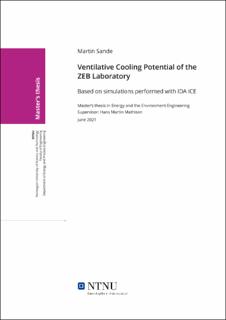| dc.contributor.advisor | Mathisen, Hans Martin | |
| dc.contributor.author | Sande, Martin | |
| dc.date.accessioned | 2021-10-05T17:38:23Z | |
| dc.date.available | 2021-10-05T17:38:23Z | |
| dc.date.issued | 2021 | |
| dc.identifier | no.ntnu:inspera:80323884:17912646 | |
| dc.identifier.uri | https://hdl.handle.net/11250/2787903 | |
| dc.description.abstract | Velisolerte bygninger, som Zero Emission Buildings (ZEB), utsettes for en høy forekomst av overoppheting i kjølesesongen. Kjøling blir nødvendig for å oppnå et godt termisk miljø, men mekanisk kjøling har et høyt energiforbruk og er ikke tillatt i henhold til Norsk standardkriterier for passivhus og lavenergibygg. Passiv kjøling blir en nødvendig strategi for å oppnå et tilfredsstillende termisk miljø.
ZEB-laboratoriet er et kontor- og utdanningsbygg i Trondheim, Norge. Det er en arena der nye og innovative komponenter og løsninger utvikles, undersøkes, testes og demonstreres i gjensidig samhandling med beboerne i bygningen. Denne masteroppgaven undersøker muligheten for å bruke naturlig ventilasjon for å levere ventilasjonskjøling til ZEB-laboratoriet. En kontrollalgoritme ble opprettet for å levere ventilativ kjøling gjennom vinduer under utilfredsstillende termiske eller atmosfæriske forhold. Kontrollalgoritmens settpunkt verdier ble spesifisert etter å sikre hygienisk ventilasjon som gir termisk komfort til beboerne. Potensialet for reduksjon av viftebruk fra den mekanisk ventilasjonen ble også undersøkt ved å undersøke potensialet for å ventilere ZEB Laboratory med ren naturlig ventilasjon.
Resultatene av de utførte simuleringene vise til at et godt termisk miljø kan oppnås i ZEB Laboratory gjennom kjølesesongen ved bruk av ventilativ kjøling. Et kjølebehov på 141 kWh, tilsvarende et effektbehov på 0,821 kWh/m^2, ble helt fjernet med den implementerte vinduskontrollalgoritmen. Trekkrisiko ble evaluert og ansett som minimal da ventilativ kjøling hovedsakelig ville bli brukt i perioder med høye innetemperaturer, perioder der trekk antas å gi en behagelig kjølende effekt.
Ventilering av ZEB Laboratory med ren naturlig ventilasjon resulterte i et uakseptabelt inneklima. Vinduskontrollalgoritmen forbyder vindusdrift i perioder med uakseptabel omgivelsestilstand, noe som resulterer i perioder der bygningen ikke ble ventilert. Med implementeringen av en mekanisk ventilasjonskontrollalgoritmen, kan totalt 68% timer med mekanisk ventilasjon erstattes med naturlig ventilasjon mens det oppnås et godt inneklima, noe som resulterer i et vifteeffektbehov på 3,58 kWh. Ren naturlig ventilasjon av ZEB Laboratory under de presenterte forholdene kan ikke anses som en akseptable løsning for ventilering av bygget.
På grunn av usikkerhet angående trekkrisiko i okkuperte soner og potensiell kortslutning av først of fjerde etasjene av ZEB Laboratory, ble hybridventilasjonsløsningen med ventilativ kjøling levert av vindusstyring valgt som den beste ventilative kjølestrategien for ZEB Laboratory i sommersesongen. | |
| dc.description.abstract | Well-insulated buildings, such as Zero Emission Buildings (ZEB), are subjected to a high occurrence of overheating during the cooling season. Cooling becomes necessary to achieve a good thermal environment. However, mechanical cooling has a high energy consumption and is not permitted by the Norwegian Standard criteria for passive house and low-energy buildings. Passive cooling becomes a necessary strategy in achieving a satisfactory thermal environment.
The ZEB Laboratory is an office and educational building located in Trondheim Norway. It is an arena where new and innovative components and solutions are developed, investigated, tested, and demonstrated in mutual interaction with the occupants of the building. This master thesis investigates the possibility of using natural ventilation to supply ventilative cooling to the ZEB Laboratory. A control algorithm was created to supply ventilative cooling through windows during unsatisfactory thermal or atmospheric conditions. The controller setpoints were specified to ensure hygienic ventilation that provides thermal comfort to occupants. The potential of fan power reduction from mechanical ventilation use was also explored by investigating the potential for ventilating the ZEB Laboratory with clean natural ventilation.
The results of the conducted simulations conclude that a good thermal environment could be provided in the ZEB Laboratory through the cooling season, using ventilative cooling. A cooling demand of 1141 kWh, corresponding to a power demand of 0,821 kWh/m^2 was entirely removed with the implemented window control algorithm. The draught risk was evaluated and deemed minimal as ventilative cooling would mainly be utilized in periods with high indoor temperatures, periods where draught is assumed to provide a comfortable cooling effect.
Ventilating the ZEB Laboratory with clean natural ventilation resulted in an unacceptable indoor environment. The window control algorithm prohibits window operation during periods of an unacceptable ambient condition resulting in periods where the building was not ventilated. With the implementation of a mechanical ventilation control algorithm, a total of 68% of hours of mechanical ventilation could be replaced with natural ventilation while achieving an good indoor environment, resulting in a fan power requirement of 3,58 kWh. Clean natural ventilation of the ZEB Laboratory under the presented conditions was not an acceptable ventilative solution.
Due to uncertainty regarding draught risk in occupied zones and the potentially short-circuiting of the ground and third floor of the ZEB Laboratory, the hybrid ventilation solution with ventilative cooling supplied by window operation was chosen as the best ventilative cooling strategy for the ZEB Laboratory through the summer season. | |
| dc.language | eng | |
| dc.publisher | NTNU | |
| dc.title | Ventilative Cooling Potential of the ZEB Laboratory | |
| dc.type | Master thesis | |
